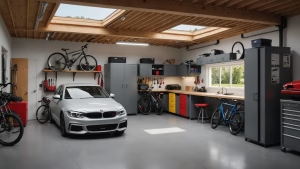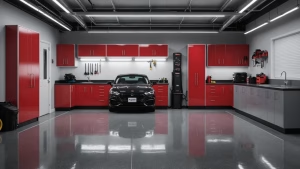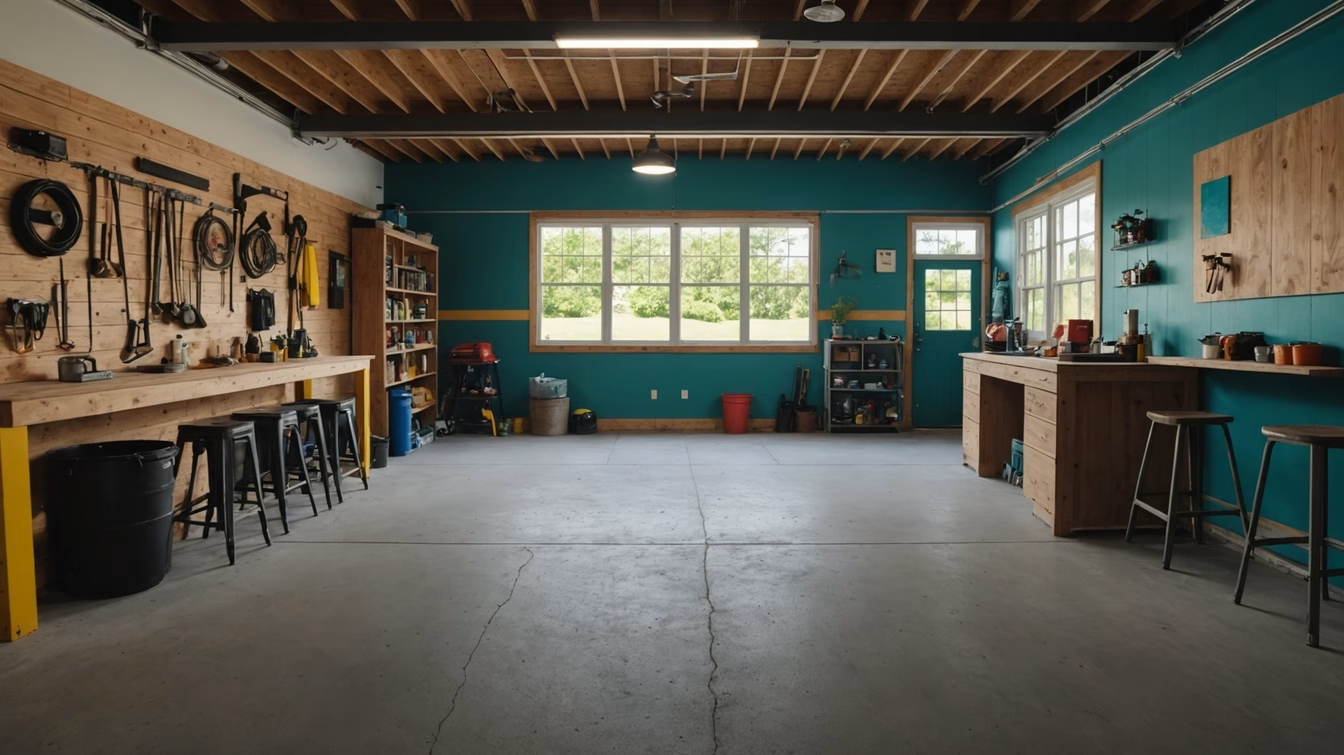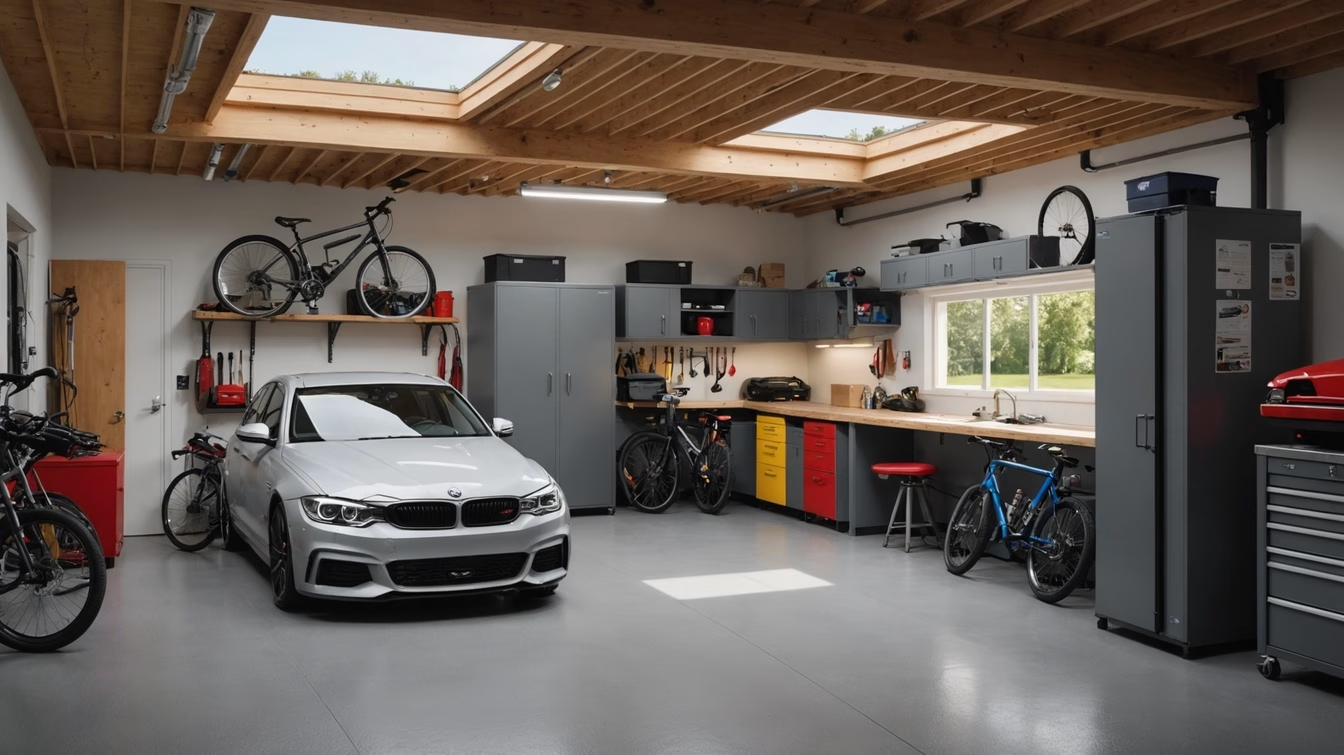Transforming a garage into a Garage-to-Garden space is a trend among homeowners. They aim to merge indoor comfort with outdoor living space transformation. By repurposing this area, families connect their home with the backyard seamlessly. Gardening expert Francine Raymond showed this in the Daily Telegraph, turning her garage into a garden room with a potting shed. She kept it functional as a garage, proving how sliding glass doors or screens can transform it into a green space design center.
Today, homeowners are turning garages into hybrid zones. Swapping garage doors for windows or screens brings in natural light. Adding outdoor furniture and plants creates a seamless transition. This setup allows the space to serve as storage, a garden hub, or even a temporary workspace. The essence lies in flexibility—keeping the garage’s original purpose while adding value through smart green space design. The following sections will offer tools, budget tips, and real-life examples to help you embark on your Garage-to-Garden project.
The Benefits of Transforming Your Garage into a Garden Oasis
Turning a garage into a garden offers more than just extra space for plants. Garden renovation projects, like Francine’s, create functional areas without the need for expensive home expansions. Her garage now serves as both a propagation station and a winter plant shelter. This shows how repurposing space for a garden can change how we use existing structures.
With the right insulation and lighting, gardening is possible all year round. Keeping temperatures between 65-80°F and humidity at 60-80% ensures plants thrive indoors. This setup eliminates seasonal gardening limitations, allowing for the growth of vegetables like carrots and radishes even in harsh winters.
Such spaces also enhance mental well-being. Being surrounded by greenery reduces stress and connects us to nature, even in urban areas. Francine mentioned her garage garden became a “peaceful retreat,” highlighting the emotional benefits of blending indoor and outdoor spaces.
Property values increase when outdoor living space transformation ideas are applied indoors. Garages with skylights or climate control add significant resale value. As buyers increasingly seek versatile spaces, this change is a wise investment.
Planning Your Garage-to-Garden Project
Turning a garage into a garden requires careful planning. First, check local building codes and obtain necessary permits. This is critical, even for minor changes like insulation or plumbing. The type of garage matters too; attached garages often need less work than detached ones.
Consider the garage’s natural light, ceiling height, and walls. These factors will shape your garden’s layout and design. A well-thought-out plan is essential for a successful transformation.
Creating a budget is vital. Garage-to-garden projects in the UK can cost between £600 and £1,800 per square meter. DIY landscaping can significantly reduce these costs. Opt for affordable materials like Smartply MDF for walls or recycled windows.
Francine’s project demonstrates budget-friendly options, such as under-£100 shelving and concrete floor paint. Don’t forget to budget for electrical upgrades, as outdated wiring can be expensive to replace.
When designing, balance beauty with functionality. Sketch out different areas for your garden, like seating or planting zones. It’s also important to check zoning laws, as some areas require permits for garden rooms used as living spaces.
Seasonal considerations are key. Ensure your windows allow for winter light and summer ventilation. Set aside 20% of your budget for unexpected expenses, such as asbestos removal or foundation repairs.
While you might need professional help for structural changes, DIY landscaping can handle plants and pathways. Begin with a small phase, like installing a base layer of soil or adding potted plants. Always check local regulations on garage conversions, as some areas have parking restrictions. A well-planned project can increase your home’s value by up to 20%. But, always verify building codes before starting.
Essential Tools and Materials for Your Project
When starting your project, choose eco-friendly options. Smartply’s MDF panels create durable walls, while weatherproof concrete paint makes floors affordable. These selections blend style with sustainability, perfect for green space design.
Lighting upgrades, like clear polycarbonate roofing, increase natural light, as seen in Jacques’ project. Combine this with LED strips or adjustable lamps for balanced illumination. Skylights and glass doors further enhance daylight, reducing the need for artificial light.
For flooring, select materials that handle indoor-outdoor transitions well. Outdoor vinyl, tile, or painted concrete are good choices. Ensure they are moisture-resistant to withstand seasonal changes and heavy use.
Maximize space with smart storage solutions. Pegboards improve tool visibility by 40%, while labeled bins reduce search time by 25%. Vertical shelves and heavy-duty bins can hold up to 50 pounds, keeping tools organized. Overhead systems add 30% more space, ideal for small garages.
Creating an Indoor Garden Area
Repurposing space for a garden opens up year-round growing possibilities. Transform your garage into a thriving urban gardening center. It can have zones for both indoor and outdoor plants. Francine’s setup includes over-wintering plants like geraniums and a banana palm that thrive in seasonal transitions. Choose compact vegetables like lettuce, radishes, and herbs that flourish in limited spaces.
Vertical solutions like wall shelves maximize floor space. Systems like Fleximounts support up to 440 pounds, perfect for tiered planters.
LED grow lights boost yields by 20-50% by mimicking sunlight. Pair them with soil enriched by humates to retain moisture and nutrients. A lettuce grow tower, a self-watering hydroponic system, allows leafy greens to thrive without soil. Position workspaces near windows for natural light, adding a potting bench for easy seedling care.
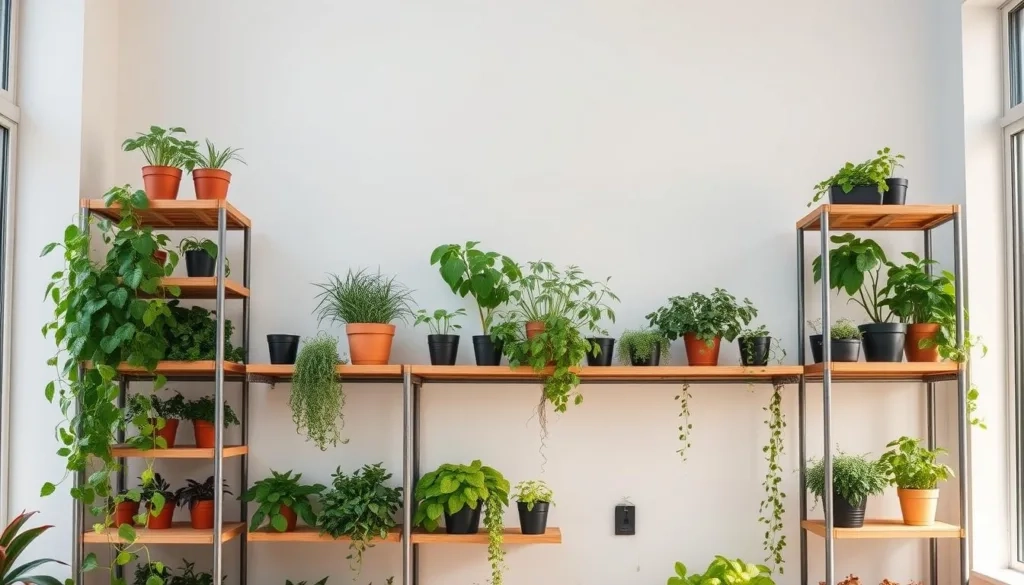
Urban gardening in garages reduces grocery bills by up to 30% while cutting food transportation emissions by 25-50%. Plants like microgreens mature in 30 days, providing quick harvests. Sustainable gardening techniques like composting kitchen scraps and using rainwater for irrigation minimize waste. Vertical designs save 80% space compared to traditional methods, fitting even small garages.
Design for seasonal shifts: move tender plants indoors in winter and reintroduce sun-loving varieties like peppers in warmer months. A well-organized space with wall-mounted tools and stackable containers keeps everything accessible. Indoor gardens also improve air quality, removing pollutants and boosting mental health. With proper planning, a garage can become a sustainable oasis yielding fresh produce and improving home aesthetics.
Designing an Outdoor Garden Space
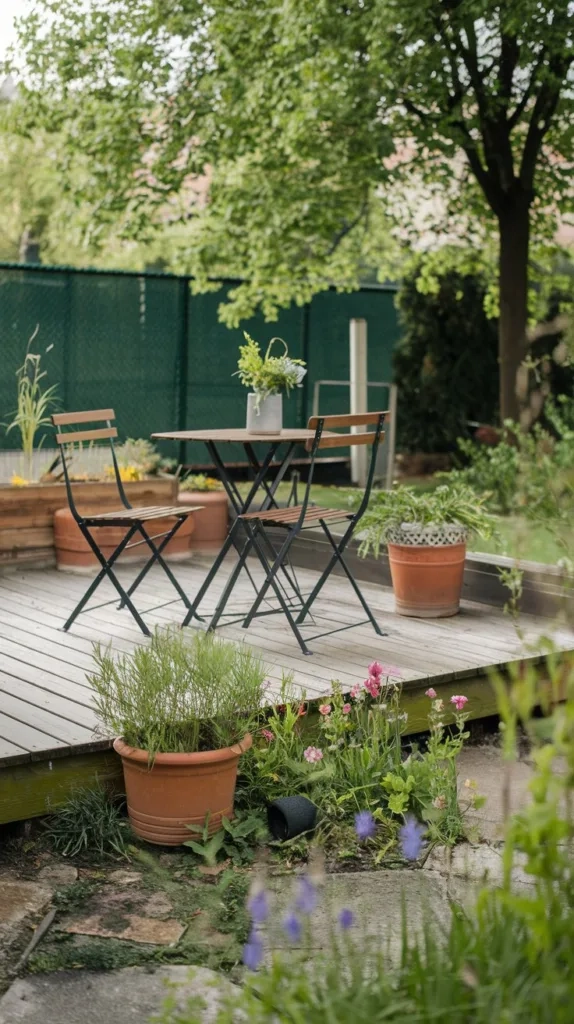
Turning your garage into a versatile space begins with outdoor garden design. Start by merging indoor and outdoor elements, such as sliding glass doors or screens. This connects your garage’s interior with the outside greenery. Matching flooring materials across both areas ensures a seamless look, making the backyard makeover feel unified.
DIY landscaping excels when focusing on structure and function. Incorporate cedar-sheathed pillars or stone pathways to solidify your design. For small spaces, vertical gardens and container plants are ideal. Consider yew hedges for heavy soil or Rosa ‘Souvenir de la Malmaison’ arches for height.
Use hornbeam on clay soils and beech on lighter soils for natural barriers. Pathways and curved lines not only guide movement but also enhance the space’s beauty.
Create garden rooms with hedging or fences to establish intimate areas. A stone patio near the house is perfect for entertaining. Low retaining walls on slopes keep views open. Solar lighting extends evening use, and drought-tolerant plants like lavender reduce maintenance.
Farrow & Ball’s ‘String’ paint on fences adds style without sacrificing practicality. Each element should contribute to both beauty and function, whether it’s a meditation nook or a dining area.
Multi-Functional Spaces: Combining Garage and Garden
Turning a garage into a garden doesn’t mean losing its original use. Francine’s setup is a perfect example of balancing both functions. Her garden room serves as a potting shed but also makes room for a car when needed. This outdoor living space transformation method offers flexibility without permanent changes. It’s ideal for those who want to adapt their space seasonally.
Zoning techniques, like partial walls or folding screens, help separate the garden from the garage. Rolling workstations and stackable planters allow for quick layout changes. For example, Stephen Ryan and Craig’s garage can transform into a gallery, dining area, or storage space. They use mobile shelving and fold-down tables to achieve this. Such solutions show that even small urban gardening projects can coexist with garage functions.
Invest in modular furniture and adjustable storage to enhance adaptability. Lightweight benches that serve as seating and shelving, or planters with hidden wheels, make easy reconfiguration possible. Keeping pathways clear and using lightweight decor ensures the space remains functional for cars when needed. With thoughtful planning, a garage can become a year-round space for creativity and relaxation, while maintaining its core utility.
Seasonal Considerations for Your Garage-to-Garden
Winter brings unique challenges to garage-to-garden spaces. Plants like Francine’s banana palm need insulation to survive. Bubble wrap or foam boards on walls can help retain warmth without altering the structure. Sealing garage doors with weatherstripping prevents cold air from entering, and using 3-IN-ONE lubricants ensures smooth door operation. Dehumidifiers are essential in humid areas to protect plants from mold.
Summer heat requires careful cooling measures. Shade cloths over windows can reduce glare, and oscillating fans help circulate air. Ventilation gaps in walls enhance airflow, and evaporative coolers are effective in dry climates. Storing heat-sensitive tools overhead frees up floor space, and pegboards are ideal for hand tools. Steel sheds are superior in withstanding wind and rain compared to wood.
Seasonal changes necessitate adaptable layouts. Move tropical plants indoors during cold snaps and return them as temperatures warm up. Keep track of frost dates to plant warm-season crops after the last spring freeze. Use frost cloths to protect sensitive vegetables like tomatoes. In winter, store snowblowers and switch to leaf blowers in fall, utilizing overhead racks to declutter counters.
Embracing sustainable gardening practices enhances year-round efficiency. Mulch insulates roots in winter and retains moisture in summer. Recycling containers for seasonal plant swaps and composting fallen leaves are beneficial. Staying informed about local weather alerts allows for timely adjustments. Proper tool maintenance extends their life, reducing waste. By following these tips, your garage-to-garden remains vibrant across all seasons.
Eco-Friendly Practices in Your Garage-to-Garden
Starting with material choices is key to sustainable gardening. Francine’s project uses Smartply, a low-emission MDF alternative, at £20 per sheet. This choice not only reduces environmental impact but also complements architectural aesthetics. Trex Transcend Composite Decking, made from 95% recycled materials, and Bradstone’s permeable paving with 83% recycled content, offer durable, eco-friendly options for outdoor layouts. These materials align with urban gardening trends, cutting carbon footprints tied to traditional cement-based products.
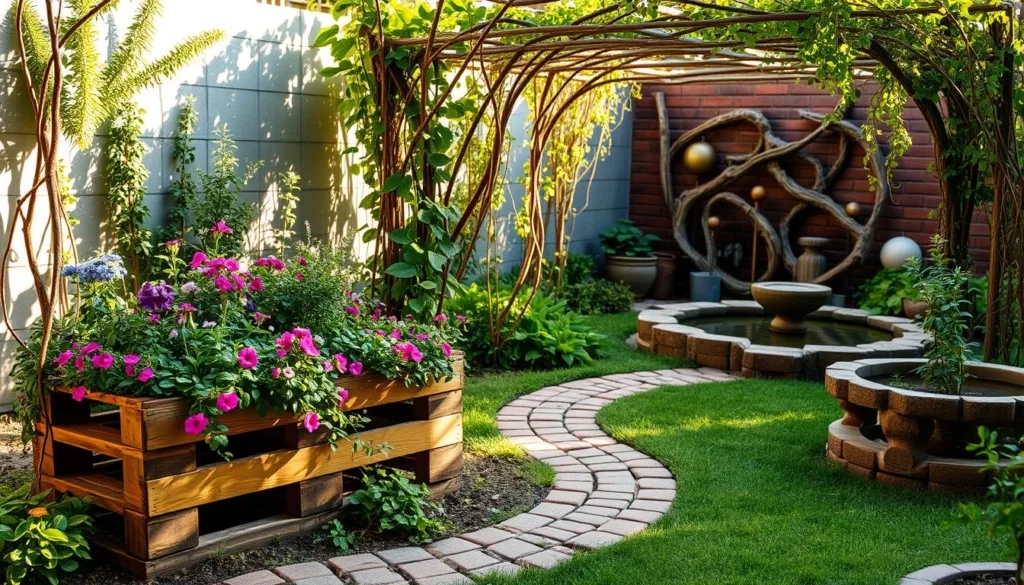
Water conservation is vital. Installing rainwater harvesting systems, like rain butts on downpipes, captures free water for plants. Drought-resistant containers, such as large pots, reduce irrigation needs. Composting organic waste replaces peat-based soils, which take millennia to form, protecting fragile ecosystems. Peat-free mixes enrich soil while supporting beneficial insects. Companion planting, like onions near roses, naturally combats pests like black spot, minimizing chemical use.
Energy efficiency enhances sustainability. Solar-powered lights or small-scale panels can power garden tools. Permeable surfaces, now mandated for driveways over 5m², prevent runoff and support local flood management. Native wildflowers, grown via seed bombs, attract pollinators like bees and butterflies, boosting biodiversity. Log piles and hedgehog habitats, endorsed by the British Hedgehog Preservation Society, encourage wildlife while requiring minimal upkeep. These practices turn garages into thriving eco-spaces that balance beauty with environmental stewardship.
Budgeting Your Garage-to-Garden Transformation
Turning a garage into a garden doesn’t have to drain your wallet. Start by focusing on DIY tasks like painting the concrete floors. Francine saved on flooring by using concrete paint, which costs $20–$40 per gallon. It can cover up to 300 sq ft, cutting down on labor costs.
Simple projects like shelving or planting stations also help avoid high labor fees. These fees often account for 30% of the total project costs.
Smart budgeting involves prioritizing high-impact upgrades. Investing in quality glass doors or lighting can add value without overspending. Basic garage conversions cost $40–$70 per sq ft, but elaborate designs can exceed $100 per sq ft.
Allocate 20% of your budget to materials. Choose vinyl siding or metal over brick to save upfront costs. A $1,000 starter budget can cover painting, shelving, and basic planters. For a $5,000 mid-range budget, consider glass walls and energy-efficient lighting, boosting home value by up to 15%. Larger budgets can include vertical storage solutions to maximize space.
Always save 10–15% of your budget for unexpected expenses. Compare contractor quotes and buy materials during off-season sales. DIY tasks like wall painting are cost-effective, while hiring pros for structural work is necessary. A well-planned Garage-to-Garden can enhance your backyard makeover without breaking the bank.
Inspirational Garage-to-Garden Transformations
Real-world examples show the Garage-to-Garden concept is a success. Francine Raymond turned her garage into a garden room with a potting area. This blend of indoor and outdoor elements is a testament to the concept’s effectiveness. Stephen Ryan and his partner transformed their garage into a space for art exhibitions and dinners, demonstrating its versatility. Arbor & Co. created a cozy garage living room with hardwood floors and neutral tones, proving small spaces can be inviting.
High-end features like glass walls and climate control systems are not exclusive to large budgets. Tess’s Melwood Workshed, with double glass doors and sliding windows, shows how natural light and airflow can be achieved affordably. Her 3.2m x 5.4m space now offers year-round comfort with climate control, transforming a stifling garage into a creative ceramics studio. Using salvaged slate tiles and native plants, she reduced costs without sacrificing aesthetic appeal.
Every Garage-to-Garden project begins with a vision. Tess’s studio, once dark and cramped, now connects her to nature through open windows and garden views. These stories illustrate how thoughtful design can transform limited spaces into functional outdoor living areas. Whether focusing on eco-friendly practices or boosting curb appeal, these examples show a garage can evolve into a sanctuary. Start small: repurpose a corner, add potted plants, or install a bench. Over time, these spaces can become the heart of your backyard makeover—a place where creativity and nature thrive together.





